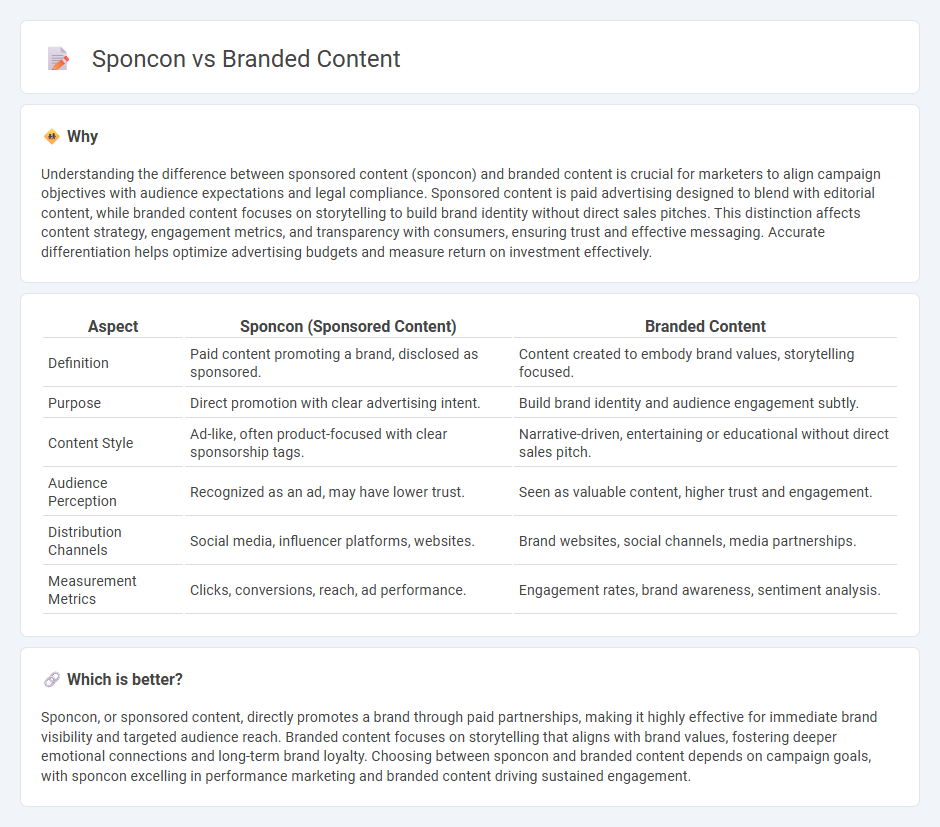
Sponsored content integrates advertising seamlessly within editorial environments, enhancing brand visibility while maintaining audience engagement. Branded content focuses on storytelling that reflects the brand's values and ethos, fostering long-term loyalty through emotional connection. Discover more about how these marketing strategies can elevate your brand impact.
Why it is important
Understanding the difference between sponsored content (sponcon) and branded content is crucial for marketers to align campaign objectives with audience expectations and legal compliance. Sponsored content is paid advertising designed to blend with editorial content, while branded content focuses on storytelling to build brand identity without direct sales pitches. This distinction affects content strategy, engagement metrics, and transparency with consumers, ensuring trust and effective messaging. Accurate differentiation helps optimize advertising budgets and measure return on investment effectively.
Comparison Table
| Aspect | Sponcon (Sponsored Content) | Branded Content |
|---|---|---|
| Definition | Paid content promoting a brand, disclosed as sponsored. | Content created to embody brand values, storytelling focused. |
| Purpose | Direct promotion with clear advertising intent. | Build brand identity and audience engagement subtly. |
| Content Style | Ad-like, often product-focused with clear sponsorship tags. | Narrative-driven, entertaining or educational without direct sales pitch. |
| Audience Perception | Recognized as an ad, may have lower trust. | Seen as valuable content, higher trust and engagement. |
| Distribution Channels | Social media, influencer platforms, websites. | Brand websites, social channels, media partnerships. |
| Measurement Metrics | Clicks, conversions, reach, ad performance. | Engagement rates, brand awareness, sentiment analysis. |
Which is better?
Sponcon, or sponsored content, directly promotes a brand through paid partnerships, making it highly effective for immediate brand visibility and targeted audience reach. Branded content focuses on storytelling that aligns with brand values, fostering deeper emotional connections and long-term brand loyalty. Choosing between sponcon and branded content depends on campaign goals, with sponcon excelling in performance marketing and branded content driving sustained engagement.
Connection
Sponsored content and branded content overlap as marketing strategies that create authentic, value-driven material aligned with a brand's identity to engage target audiences. Both approaches focus on storytelling and seamless integration into media channels to enhance brand awareness and consumer trust. Their connection lies in blending promotional messages with entertainment or informative content to drive higher audience engagement and conversion rates.
Key Terms
Authenticity
Branded content emphasizes creating genuine narratives that align with a brand's values, fostering trust and long-term audience engagement. Sponcon, or sponsored content, often prioritizes immediate visibility but can risk appearing less authentic if overly promotional. Explore the nuances between branded content and sponsored content to enhance your marketing strategy effectively.
Disclosure
Branded content requires clear disclosure to ensure transparency, distinguishing it from sponcon, which relies heavily on influencer marketing without always explicitly labeling the partnership. The Federal Trade Commission (FTC) mandates that sponsored content must be clearly identified to prevent misleading consumers about the nature of the endorsement. Explore more about how proper disclosure impacts audience trust and legal compliance in digital marketing.
Brand Integration
Branded content seamlessly weaves a brand's message into engaging storytelling without overt product promotion, enhancing brand integration through subtle reinforcement. Sponsored content (sponcon) explicitly features the brand or product, often in a promotional context, prioritizing direct visibility and immediate consumer association. Explore the nuances of brand integration strategies to optimize content effectiveness and audience engagement.
Source and External Links
Branded Content: What It Is & How to Create It - Semrush - Branded content is content created in partnership with a publisher or advertiser to convey a company's values and connect emotionally with audiences, making people feel like they aren't being sold to and encouraging sharing and interaction.
Branded Content Definition: 3 Content Marketing Examples - MasterClass - Branded content is a marketing strategy that builds brand awareness and loyalty by telling a brand's story or values through formats like social media, podcasts, or short films, focusing on selling an idea or feeling rather than the product directly.
What Is Branded Content? (With Advantages and Examples) - Indeed - Branded content is marketing media created to promote a business or product by engaging and educating audiences in an entertaining way, often produced or published by marketers or influencers to attract and maintain customers.
 dowidth.com
dowidth.com